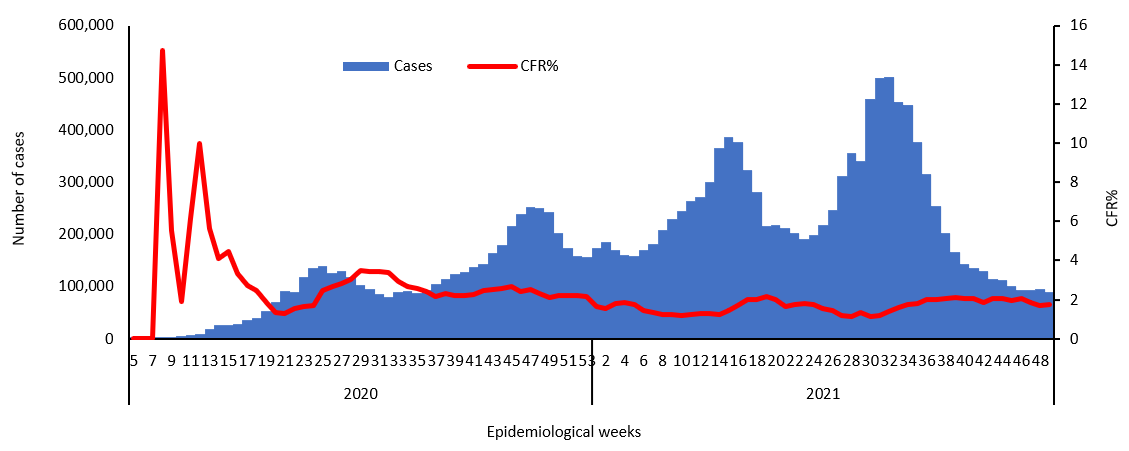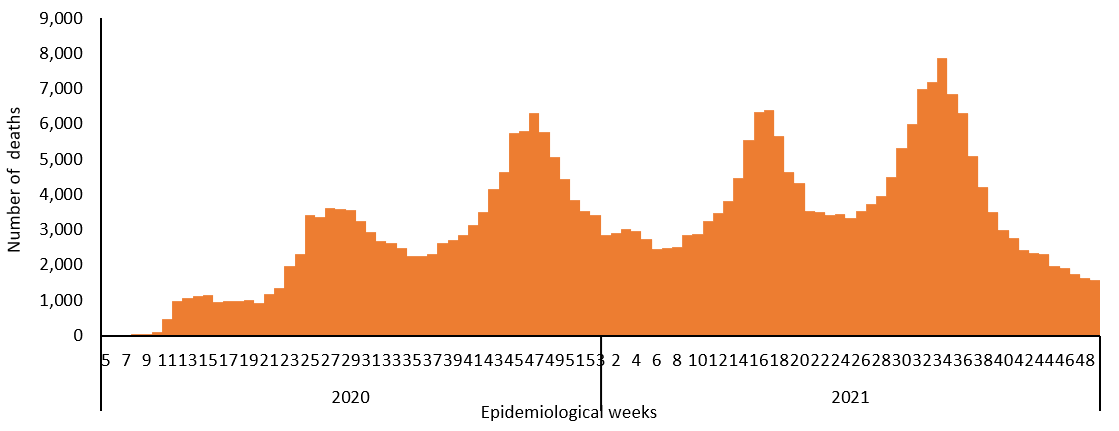The coronavirus disease COVID-19 continues to spread at the regional and global levels. As of 11 December 2021, the global cumulative incidence reached 268 522 781reported cases and 5 299 210 associated deaths with a case fatality ratio (CFR) of 2%. Meanwhile, the 22 countries of the Eastern Mediterranean Region (EMR) have reported a total of 16 938 021 cases, which represent about 6.3% of the global count, with 312 325 associated deaths (CFR 1.8%). Most countries in the Region are in the community transmission phase.
Since the beginning of the outbreak, the country that has reported the highest number of total cases in the Region is Islamic Republic of Iran (6 152 524 cases; 36.3% of the Region’s total), followed by Iraq (2 087 497; 12.3%) and Pakistan (1 289 049; 7.6%). Islamic Republic of Iran also reported the highest number of total associated deaths (130 661; CFR 2.1%) followed by Pakistan (28 830; CFR 2.2%) and Tunisia (25 432; CFR 3.5%). The highest CFRs were reported by Yemen (19.6%) followed by Sudan (7.2%), while the lowest CFRs were reported by Qatar (0.25%), United Arab Emirates (0.29%) and Bahrain (0.5%).
During epidemiological week 49, the Region reported a decrease in cases of 4.6% when compared to the previous week (90 500 cases compared to 94 887 cases). Similarly, a decrease of 3.4% was observed for associated deaths (1576 deaths compared to 1631deaths).
Jordan, Sudan and Egypt reported a relative increase in COVID-19 activity in week 49. The cumulative number of cases increased from 971 401 to 1 006 136 in Jordan (a 3.6% weekly increase), from 44 075 to 44 877 in Sudan (a 1.8% weekly increase) and from 362 260 to 368 335 in Egypt (a 1.7% weekly increase). Jordan, Egypt and Sudan had the largest relative increase in deaths.
In terms of testing, a total of 279 799 505 laboratory PCR tests were conducted since the start of the outbreak across the Region including 4 559 203 tests in week 49, which shows a 0.2% increase compared to the previous week when 4 549 648 tests were conducted. The highest number of PCR tests were reported from United Arab Emirates (104.2 million), followed by Islamic Republic of Iran (39.9 million) and Saudi Arabia (31.9 million). The United Arab Emirates and Bahrain are performing the highest rates of testing per capita (10 451/1000 and 4351/1000, respectively). The average positivity rate for the Region is 6.1%. WHO recommends a positivity rate of around 3–12% as a general benchmark indicating adequate testing, which was achieved in most countries of the Region.
Meanwhile, COVID-19 vaccination continues across the Region. The total number of doses administered so far in the 22 countries is 484 095 297. Pakistan has administered the highest number of doses at 133 613 045, followed by Morocco at 49 316 418 and Saudi Arabia at 48 104 413. On the other hand the total number of administrated doses in Sudan is 3 276 654, in Libya is 2 536 160, in Syria is 1 517 253, in Somalia is 1 147 627, in Yemen is 786 027 and in Djibouti is 117 874.*
Supporting countries in the Region
The regional incident management support team continues to coordinate the response and provide technical support to countries and partners in the Region in the areas of coordination and partnership, surveillance, laboratory capacity, clinical management, infection prevention and control, risk communication and community engagement, points of entry according to the International Health Regulations (2005), research, health systems, and essential health services among others.


For more data from the Region, please visit the COVID-19 dashboard.
*The data on vaccination is obtained from a number of sources including media reports and country websites for ministries of health.
Subscribe to the monthly infectious hazard preparedness newsletter of WHO’s Health Emergencies Programme for latest data and analysis on epidemic- and pandemic-prone diseases, as well as news on outbreak preparedness and response within WHO’s Eastern Mediterranean Region.




